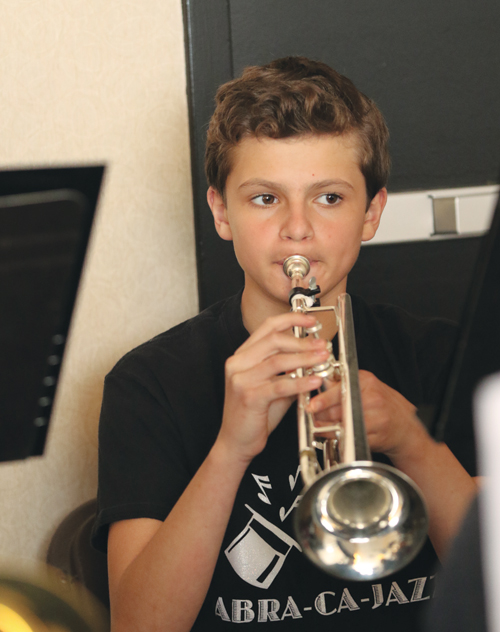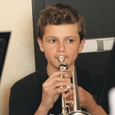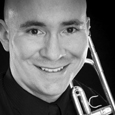
The development of music pedagogy has led to a number of short-term solutions that often produce desirable results from young brass players. However, when considering long-term development as musicians it is important to consider what these practices may or may not be doing for students. In efforts to manufacture a mature-sounding ensemble there exists the possibility of inhibiting the long-term growth of young brass players. Here are some potentially harmful comments brass players commonly hear, along with better choices for each.
Taking a Good Breath
When teaching students about breathing it is important to remember some key ideas. First, the lungs are behind the rib cage. Second, air has no shape unless it is held within a completely full container, such as a balloon or air mattress; it cannot go into our stomachs first, and we cannot physically make the air enter our bodies from the bottom. Third, most students have no idea what the diaphragm is, where it is located, or what it does. It is also worth noting that the diaphragm is a partially involuntary muscle, so full control over it is impossible. Encouraging students to breathe from it or even to focus on using it can frequently add confusion and extra tension from increased efforts to achieve what is physically impossible. Although the goal here may be for students to place tension lower in the body and away from the neck and shoulders, verbiage encouraging students to do what cannot be done can lead them to develop substantial bad habits.
When asking educators and students about breathing I frequently hear that the shoulders should not be allowed to rise during inhalation. This is a case of good intentions that lead to poor results. When taking a good breath the shoulders should be allowed to rise a little – not up to the ears, but a little. Remember that the lungs are behind the ribs, and when they are full the shoulders rise a little over an inch. Forcing the shoulders downward while breathing can add tension at the base of the neck and slow down the air column, which makes airflow, tone quality, and attack more difficult.
For improved results, simplify the verbiage. Allow breathing to be something natural and conversational, not something requiring superhuman effort.
Encourage students to breathe from the belly button to the collarbone when they are about to play. Although we know it is impossible to place the beginning of the breath at specific points within the body, thinking of breathing in such a way can help place tension in the core of the body and not in places where students should avoid it, such as the neck or embouchure. If students breathe this way, they don’t need to think about what their muscles are doing.
Once this motion is achieved, the final step to getting a good breath is making it rounded, meaning that the exhalation/attack fully mirrors the inhalation without slowing down or stopping the air as it enters and leaves the body. Imagining the breath from the belly button to the collarbone when combined with efforts to round the breath and attack should offer a very simple and effective way to gain improved results in the band room.
Air
There have been hundreds of phrases used in an attempt to describe air when it is working well; a few of these include a thick air column, slow air, fast air, more air, less air, warm air, and cold air. The big problem is that speaking about air in such terms to our students frequently opens the door to physical dysfunction. Specifically, students increase their physical efforts in ways that increase tension and lessen resonance, and they get into the habit of overblowing, which ruins sound quality and is an extremely difficult habit to break once it is established.
To get students to experience uninterrupted airflow, have them try an exexcise with a candle. Place a lit candle on a sturdy music stand or table at chest height. Have a student stand a comfortable distance away from the stand, and play a passage in which a possible lack of airflow may be hindering performance. Pick a note anywhere in the passage where it seems air ceases to flow freely. Have the student play the passage up until that exact note, then rapidly remove the instrument from the face and aim air towards the candle. The student should not blow more as the instrument gets moved aside but keep the airflow as it was.
It is possible students will fail several times before they begin to relinquish tension and let the air actually flow freely in anticipation of blowing out the candle. This is the goal. They should hopefully learn how this feels and seek to remember it when they are performing in an ensemble. If you are uncomfortable having an open flame around your students, then large pinwheels can serve the same purpose.
Dark vs. Bright Tone
Brass instruments are made to resonate. Resonance is typically an extremely colorful and bright quality. However, brightness has been given somewhat of a bad name in music education over the past several decades. In many instances bright has become synonymous with uncontrolled, unskilled, or thin, and dark has become synonymous with controlled, skilled, or big. This sentiment may be situational, but it does exist and this is quite unfortunate.
Many educators will instruct their brass players, especially trumpets, to darken the tone. This is where we can cause serious damage to young brass musicians if they are not already advanced players. I ask teachers to sing a note with their best tone quality and at a full volume, then try to darken it. Typically, what results is added tension, unless the person is a relatively advanced musician. When tension is added in places brass players don’t need it, such as the embouchure or neck, the sound can never fully resonate the way it ought. Jay Friedman, principal trombonist of the Chicago Symphony Orchestra, summarizes this thought wonderfully: “When you flex a muscle anywhere near a column of air, that action plays havoc with the air stream, inhibiting resonance and causing a funky sound” (How Can I Say it Clearer, Jayfriedman.net).
Something that has helped me a great deal with my teaching and performing is differentiating between tone and sound. Tone is the basic voice that comes out of the instrument. It can be bright, clear, unclear, fuzzy, or resonant. Sound, however, is the artistic goal for a player. Sounds can be described in such terms as jazzy, German, British, classical, or French, just to give a few examples. One way teachers can challenge students is to have them verbally define a great tone quality. This challenges everyone who hasn’t already thought about it and established a definition. The description I use for great tone quality on any brass instrument is clear, bright and resonant.
When a darker or warmer sound is desired from the brass players, simply try asking for a change in articulation. A softer front of the note can actually make notes seem darker in an ensemble setting. This method can especially help trumpets stay resonant and bright while managing to blend with the likes of more conical sounding instruments such as horns and euphoniums. That said, if you are hearing brightness coming from the brass section, encourage it; these instruments are made to resonate.
Micromanaging
The main concern is that when we as educators attempt to micromanage the small tissues and systems of our students with such comments as “Drop the jaw,” “Don’t pull the corners back too far,” or “Keep the tongue flat,” we can lead them to undesirable results over time. Arnold Jacobs, brass pedagogue and former principal tuba with the Chicago Symphony, said it best at a masterclass: “One thing is that we never know what we are doing. Now, we have to know what we are doing as musicians, but we will never know what we are doing in the sense of physical structures at work.” In a nutshell, Jacobs always felt that the best results were produced when students were extremely focused on their musical goals but somewhat unconscious of their physical maneuvers. The first musical goal students should have is awareness of a great tone quality on their instrument.
Physical instructions are necessary from time to time, especially in the earlier stages of learning a brass instrument. However, the majority of the students on the receiving end of these instructions cannot describe or even recognize what a characteristic tone quality is on their instrument.
Far more important than nitpicky physical instructions is for students to listen to great players on their instrument regularly and have a characteristic tone quality in mind as they play. Have them listen to great players and then describe what they hear. The great tone qualities students listen to should influence every note they play. Ideally, their bodies can take them incredible distances without any overload from us as educators.






